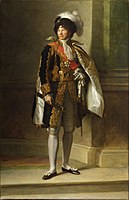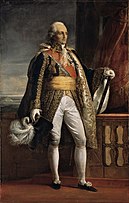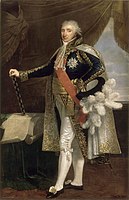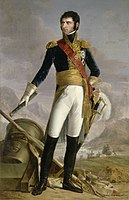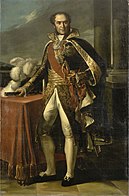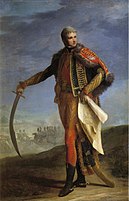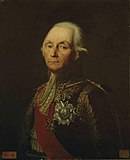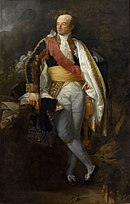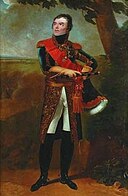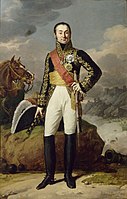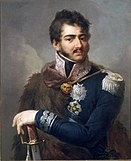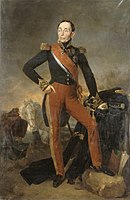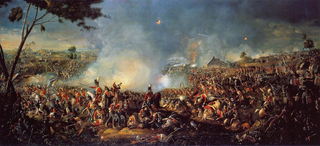
The Battle of Waterloo was fought on Sunday 18 June 1815, near Waterloo, marking the end of the Napoleonic Wars. A French army under the command of Napoleon was defeated by two armies of the Seventh Coalition. One of these was a British-led force with units from the United Kingdom, the Netherlands, Hanover, Brunswick, and Nassau, under the command of the Duke of Wellington. The other comprised three corps of the Prussian army under Field Marshal Blücher; a fourth corps of this army fought at the Battle of Wavre on the same day. The battle was known contemporarily as the Battle of Mont Saint-Jean in France and La Belle Alliance in Prussia.

The Battle of Ligny, in which French troops of the Armée du Nord under the command of Napoleon I defeated part of a Prussian army under Field Marshal Blücher, was fought on 16 June 1815 near Ligny in what is now Belgium. The result was a tactical victory for the French, but the bulk of the Prussian army survived the battle in good order, was reinforced by Prussian troops who had not fought at Ligny, and played a role two days later at the Battle of Waterloo. The Battle of Ligny was the last victory in Napoleon's military career.

Guillaume Marie-Anne Brune, 1st Count Brune was a French military commander, Marshal of the Empire, and political figure who served during the French Revolutionary Wars and the Napoleonic Wars.

Marshal General Jean-de-Dieu Soult, 1st Duke of Dalmatia was a French general and statesman. He was a Marshal of the Empire during the Napoleonic Wars, and served three times as President of the Council of Ministers of France.

The Hundred Days, also known as the War of the Seventh Coalition, marked the period between Napoleon's return from eleven months of exile on the island of Elba to Paris on 20 March 1815 and the second restoration of King Louis XVIII on 8 July 1815. This period saw the War of the Seventh Coalition, and includes the Waterloo Campaign and the Neapolitan War as well as several other minor campaigns. The phrase les Cent Jours was first used by the prefect of Paris, Gaspard, comte de Chabrol, in his speech welcoming the king back to Paris on 8 July.
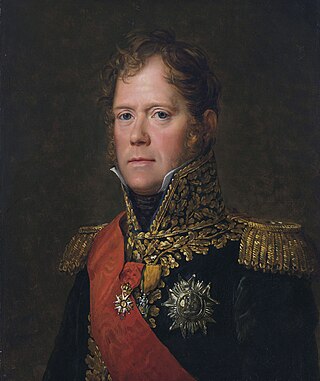
Michel Ney, 1st Prince de la Moskowa, 1st Duke of Elchingen, was a French military commander and Marshal of the Empire who fought in the French Revolutionary Wars and the Napoleonic Wars.
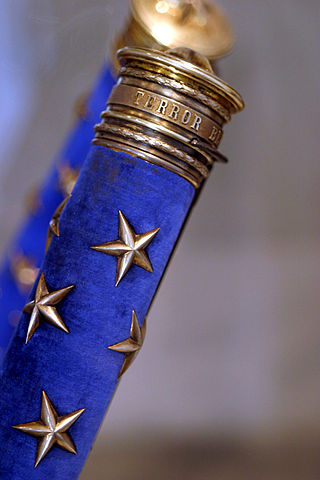
Marshal of France is a French military distinction, rather than a military rank, that is awarded to generals for exceptional achievements. The title has been awarded since 1185, though briefly abolished (1793–1804) and for a period dormant (1870–1916). It was one of the Great Officers of the Crown of France during the Ancien Régime and Bourbon Restoration, and one of the Grand Dignitaries of the Empire during the First French Empire.

Jean-Baptiste Antoine Marcelin Marbot, known as Marcellin Marbot, was a French general, famous for his memoirs depicting the Napoleonic age of warfare. He belongs to a family that has distinguished itself particularly in the career of arms, giving three generals to France in less than 50 years, including his elder brother, Antoine Adolphe Marcelin Marbot.

Louis-Nicolas d'Avout, better known as Davout, 1st Prince of Eckmühl, 1st Duke of Auerstaedt, was a French military commander and Marshal of the Empire who served during both the French Revolutionary Wars and the Napoleonic Wars. His talent for war, along with his reputation as a stern disciplinarian, earned him the nickname "The Iron Marshal". He is ranked along with Marshals André Masséna and Jean Lannes as one of Napoleon's finest commanders. His loyalty and obedience to Napoleon were absolute. During his lifetime, Davout's name was commonly spelled Davoust - this spelling appears on the Arc de Triomphe and in much of the correspondence between Napoleon and his generals.

Jean Lannes, 1st Duke of Montebello, Prince of Siewierz, was a French military commander and a Marshal of the Empire who served during both the French Revolutionary and Napoleonic Wars.

Louis-Alexandre Berthier, Prince of Neuchâtel and Valangin, Prince of Wagram, was a French military commander who served during the French Revolutionary Wars and the Napoleonic Wars. He was twice Minister of War of France and was made a Marshal of the Empire in 1804. Berthier served as chief of staff to Napoleon Bonaparte from his first Italian campaign in 1796 until his first abdication in 1814. The operational efficiency of the Grande Armée owed much to his considerable administrative and organizational skills.

Joachim Murat was a French military commander and statesman who served during the French Revolutionary Wars and Napoleonic Wars. Under the French Empire he received the military titles of Marshal of the Empire and Admiral of France. He was the first Prince Murat, Grand Duke of Berg from 1806 to 1808, and King of Naples as Joachim-Napoleon from 1808 to 1815.

Étienne Maurice Gérard, 1st Comte Gérard was a distinguished French general and statesman. He served under a succession of French governments including the ancien regime monarchy, the Revolutionary governments, the Restorations, the July Monarchy, the First and Second Republics, and the First Empire, becoming prime minister briefly in 1834.

Emmanuel de Grouchy, marquis de Grouchy was a French military leader who served during the French Revolutionary Wars and the Napoleonic Wars. He was the last Marshal of the Empire to be created by Napoleon, and is best known for his actions during the Waterloo campaign.

The Battle of Wavre was the final major military action of the Hundred Days campaign and the Napoleonic Wars. It was fought on 18–19 June 1815 between the Prussian rearguard, consisting of the Prussian III Corps under the command of General Johann von Thielmann and three corps of the French army under the command of Marshal Grouchy. A blocking action, this battle kept 33,000 French soldiers from reaching the Battle of Waterloo and so helped in the defeat of Napoleon at Waterloo.

The Waterloo campaign was fought between the French Army of the North and two Seventh Coalition armies, an Anglo-allied army and a Prussian army. Initially the French army had been commanded by Napoleon Bonaparte, but he left for Paris after the French defeat at the Battle of Waterloo. Command then rested on Marshals Soult and Grouchy, who were in turn replaced by Marshal Davout, who took command at the request of the French Provisional Government. The Anglo-allied army was commanded by the Duke of Wellington and the Prussian army by Field Marshall Graf von Blücher.
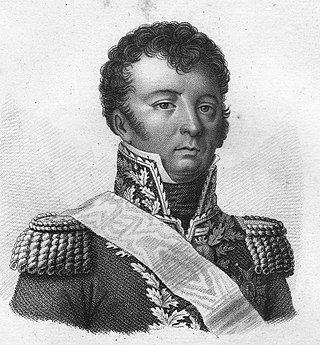
General Dominique-Joseph René Vandamme, Count of Unseburg was a French military officer, who fought in the Napoleonic Wars. He was a dedicated career soldier with a reputation as an excellent division and corps commander. However, he had a nasty disposition that alienated his colleagues, and would publicly criticize Napoleon, who never appointed him marshal.

This is the complete order of battle for the four major battles of the Waterloo campaign.

Marshal of the Empire was a civil dignity during the First French Empire. It was created by Sénatus-consulte on 18 May 1804 and to a large extent reinstated the formerly abolished title of Marshal of France. According to the Sénatus-consulte, a Marshal was a grand officer of the Empire, entitled to a high-standing position at the court and to the presidency of an electoral college.

Charles Claude Jacquinot commanded a French cavalry division at the Battle of Waterloo in 1815. He joined a volunteer battalion in 1791 and transferred to a light cavalry regiment as a junior officer in 1793. He earned promotion to squadron commander and was acting commander of his regiment at Hohenlinden in 1800. After serving in a staff position at Austerlitz in 1805, he led a light cavalry regiment at Jena in 1806. Promoted to general of brigade he led his horsemen at Abensberg, Raab and Wagram in 1809. During the French invasion of Russia he fought at Ostrovno, Smolensk and Borodino in 1812. During the 1813 German Campaign he led a cavalry brigade at Dennewitz and Leipzig. After being appointed general of division he fought at Second Bar-sur-Aube and Saint-Dizier in 1814. During the Hundred Days he rallied to Napoleon and led a light cavalry division in the Waterloo campaign. After 15 years of inactivity, he was restored to favor in the 1830s. Thereafter he held a number of commands and was appointed to the Chamber of Peers. His surname is one of the names inscribed under the Arc de Triomphe, on Column 20.



